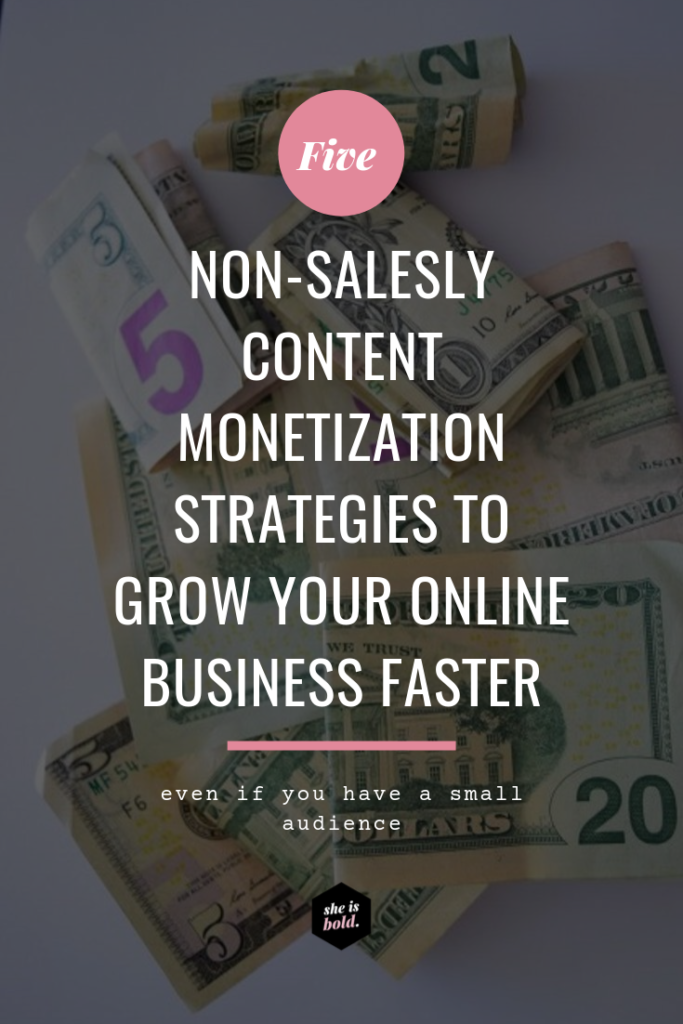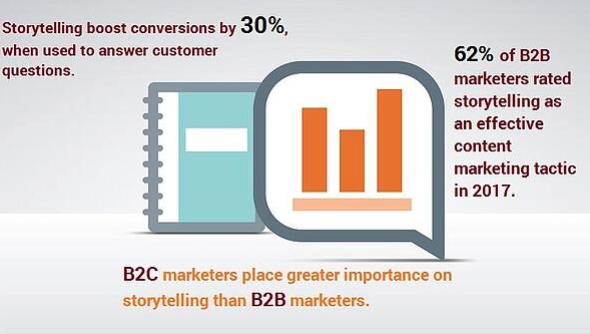Because no, successful entrepreneurs don’t just auto-magically get money just because they cranked out a blog post or showed up on social media. They get money because they have an actual strategy– a content monetization strategy in place. And hey, if you’re an introvert like me and fear of being “salesy” holds you back, then you’ll especially love these 5 non-salesy content monetization strategies I’ve used for my clients and my own biz that is going to help you grow your online business faster.

There are tons of content monetization strategies for your website to choose from, but today we’re focusing on ones that:
- don’t even require a large audience,
- work faster,
- and aren’t salesy.
PS. This post contains affiliate links and I get a commission if you click on any and purchase from them.
Let’s hit it.
1. Affiliate marketing
Affiliate marketing is no doubt a mark of smart entrepreneur. Affiliate marketing allows you to monetize content like blog posts, podcasts, and videos by simply sharing a story about how a product or service has changed your life and using a unique URL to track the conversions and get a cut of the profits.
So basically, you’re just talking about how much you love your favorite stuff and getting paid for it– pretty sweet right??
Whether you’re an entrepreneur teaching others how to run their business or you’re a lifestyle blogger who wants to be compensated for people who buy your recommended outfits… the beauty to affiliate marketing is that you can create evergreen content or simply use your affiliate link in hyperlinks throughout your blog posts and are searchable in search engines for years to come.
More eyeballs and dollar bills from search engines? Yes, please!
Affiliate marketing is especially helpful if you’re a blogger and don’t have a product or service offering, but it’s also super helpful to diversify revenue streams if you do have an offering.
Tip: Write affiliate content that gears your SEO towards your exact ideal client by adding your niche or niche’s problem to the end of your affiliate search terms or phrases.
Affiliate search formula:
Affiliate partner name + “for ideal client phrase”
or…
Affiliate search phrase + “to ( problem)
For example, If I wanted to write for my Passion Planner affiliate link, I would create a blog post title using something like:
“How I use the Passion Planner to 3x my sales goals.”
If you have lower traffic numbers for your website, consider partnering with more expensive products or services so you can score a larger chunk of change.
I’m personally obsessed with Honeybook and credit it entirely to next-leveling my coaching client experience and booking over 80% of outbound proposals. The $200 referral feed has helped me reached goals without having to work one-on-one and was reason enough for me to consider giving it a whirl!
Are you an entrepreneur looking to get started with affiliate marketing? I rounded up some of my fave partners on this post.
2. Paid ads with Facebook and Instagram
Show me an internet-famous influencer and I’ll also show you their paid ad campaign. Don’t believe me? Go visit their website and lemme’ know if their ad doesn’t find you in your Facebook or IG feed the next day.
It’s no wonder influencers make bank and grow their following so quickly. Paid ads allow you to practically ensure new ideal clients 24/7 with all the insane targeting functionality like demographics, locations, and incredibly specific interest groups.
You can literally nail down everything from marital status to targeting other pages on social media that they “like” which means you won’t be wasting a dime if you know exactly who you’re talking to.
Oh and all their ads following you? Yep, that’s the smart retargeting feature also available so you can target your ideal client with one ad, and follow up with them with another.
For example, you may be shown a stylish T-shirt and you click the ad but don’t buy— and then through Facebook ad targeting you can retarget that same person who clicked and then show them an exclusive coupon offer to entice them to come back and finalize their purchase.
Genius, right?? I mean you don’t have to feel “salesy” at all when your ads are doing all the work for you.
3. Brand story strategy
It’s no secret that “story telling” and building an “authentic” brand is all the marketing rage. But how do you actually do that?? With your brand story.
Knowing your brand story will allow you to:
- Connect with your readers on an emotional level (and psst: Readers make more emotional buying decisions than rational) and build trust and relatability
- Create a memorable brand and engage your readers more than facts
- Set you apart from the sea of competition
- Get crystal clear on how you uniquely serve your ideal client with your gifts
- and so much more!
Oh, and did I mention storytelling has all kinds of fun stats like: “storytelling boosts conversions by 30%.”

And because brand story strategy is the most authentic, non-salesy way to attract to your ideal clients, it makes content marketing hella easier when you think of it as just sharing your story, gifts, and results to serve others–which means you’ll be able to attract those ideal clients and put yourself “out there” even faster.
Wanna discover your very own brand story? Check this out.

4. Webinars
Trying to promote a high ticket item and want to book multiple customers in one sitting? Webinars are where it’s at.
Although a paid ad campaign to get webinar sign-ups would be a surefire way to get new ideal clients… you can also totally host a webinar to your existing audience as well by promoting to your existing social media platforms and newsletter list for FREE.🤗
Attract and convert your ideal client by offering a mini-training via webinar that is super relevant to your offer.
You can ditch the feeling of being salesy when you offer a high-value training that your ideal client is struggling with and change your mindset to serving vs selling and helping them figure out a solution to their problem.
Hosting a webinar also:
- Builds your authority in the subject matter,
- allows ample time to demonstrate your knowledge and expertise,
- personally connect with your viewers and answer questions on the fly,
- and allows you to generate more leads than traditional marketing channels.
Plus, you can totally record it and repurpose your webinar for things like future ad campaigns or even use it as an opt-in at the bottom of your blog posts or an awesome call to action on your podcast to grow your email list. #chaching
The best part about webinars? You can use awesome systems like Webinarjam that come with fun chat boxes and literally chat with your audience to get to know them more and connect with them instantly.
By the end of the webinar, you’ll have a relationship already established with your viewers so telling them about a product or service that would benefit them even more, will not only be so much easier than trying to pitch it to someone who doesn’t know anything about it (or you)…but also have them ready to smack that buy button by the end of it.
5. Lead magnets and sales funnels
You don’t hear the word lead magnet or opt-in for nothing these days, but it’s important not to just have one to attract your ideal client but to use one strategically to convert that email address into a customer.
There are 2 main ways to convert your lead magnet subscribers and monetize your content:
- Lead magnet to a sales funnel
- Lead magnet to direct sale
The lead magnet to sales funnel option as the name suggests takes your email subscribers from your lead magnet and puts them directly into a sales funnel.
The cool part is once you know the value of your lead magnet (ie: for every email subscriber you get, you get x revenue $ ) you’ll be able to set and reach goals with paid ads in particular because you’ll be able to forecast your ROI more accurately. Add another layer of marketing strategy on when you’re ready to scale and create and test new lead magnets to see which yields a higher ROI.
Boom. You’re a pro.
The second option, “lead magnet to direct sale”, is good if you don’t have a sales funnel in place yet. It’s basically a content monetization strategy where you email your lead magnet subscribers a relevant offer or promotion for them to make a purchase down the road.
A good rule of thumb for how frequently you should be using this “direct sales” approach in your email strategy is 80/20– 80% of the time you should be adding value to your reader and 20% you should be pitching them. So another way of saying that is for every 10 emails you send that lead magnet subscriber, 8 of them should be straight value add and no more than 2 should be asking for the sale.
Another great and highly recommended way to monetize your lead magnet subscribers (for high ticket service providers in particular) is to email them an offer to schedule a free consultation or discovery call with you.
Since high ticket shoppers typically don’t just add a $5k+ package to their “cart”, it’s crucial to get people on the phone to chat through their questions and objections before they’ll purchase.
Want even more marketing strategies? We started this thing where we hook up you up with our library of marketing trainings and downloadables and it’s 100% free.

Comments +